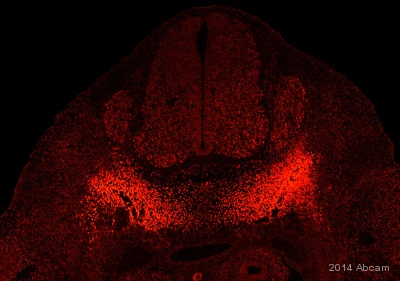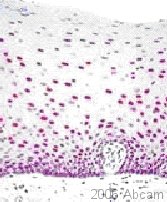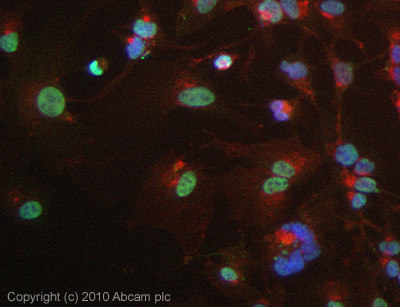Anti-PAX9 antibody [7C2]
| Name | Anti-PAX9 antibody [7C2] |
|---|---|
| Supplier | Abcam |
| Catalog | ab28538 |
| Prices | $392.00 |
| Sizes | 100 µg |
| Host | Rat |
| Clonality | Monoclonal |
| Isotype | IgG1 |
| Clone | 7C2 |
| Applications | IP IHC-F ICC/IF ICC/IF IHC-P WB FC |
| Species Reactivities | Mouse, Human |
| Antigen | Recombinant PAX9-MBP fusion protein (Mouse) |
| Description | Rat Monoclonal |
| Gene | PAX9 |
| Conjugate | Unconjugated |
| Supplier Page | Shop |
Product images
Product References
Transcriptional dynamics of endodermal organ formation. - Transcriptional dynamics of endodermal organ formation.
Sherwood RI, Chen TY, Melton DA. Dev Dyn. 2009 Jan;238(1):29-42.
Oncogenic cooperation and coamplification of developmental transcription factor - Oncogenic cooperation and coamplification of developmental transcription factor
Kendall J, Liu Q, Bakleh A, Krasnitz A, Nguyen KC, Lakshmi B, Gerald WL, Powers S, Mu D. Proc Natl Acad Sci U S A. 2007 Oct 16;104(42):16663-8. Epub 2007 Oct 9.
Pax9 is required for filiform papilla development and suppresses skin-specific - Pax9 is required for filiform papilla development and suppresses skin-specific
Jonker L, Kist R, Aw A, Wappler I, Peters H. Mech Dev. 2004 Nov;121(11):1313-22.
Progressive loss of PAX9 expression correlates with increasing malignancy of - Progressive loss of PAX9 expression correlates with increasing malignancy of
Gerber JK, Richter T, Kremmer E, Adamski J, Hofler H, Balling R, Peters H. J Pathol. 2002 Jul;197(3):293-7.


![All lanes : Anti-PAX9 antibody [7C2] (ab28538)Lane 1 : mouse oesophageal protein extractLane 2 : human oesophageal protein extract](http://www.bioprodhub.com/system/product_images/ab_products/2/sub_4/7845_ab28538_1.jpg)

![Overlay histogram showing HepG2 cells stained with ab28538 (red line). The cells were fixed with 80% methanol (5 min) and then permeabilized with 0.1% PBS-Tween for 20 min. The cells were then incubated in 1x PBS / 10% normal goat serum / 0.3M glycine to block non-specific protein-protein interactions followed by the antibody (ab28538, 1µg/1x106 cells) for 30 min at 22ºC. The secondary antibody used was goat anti-rat DyLight® 488 (IgG H+L) at 1/500 dilution for 30 min at 22ºC. Isotype control antibody (black line) was rat IgG1, kappa monoclonal [RTK2071] (ab18412, 2µg/1x106 cells) used under the same conditions. Acquisition of >5,000 events was performed. This antibody gave a positive signal in HepG2 cells fixed with 4% paraformaldehyde (10 min)/permeabilized in 0.1% PBS-Tween used under the same conditions.](http://www.bioprodhub.com/system/product_images/ab_products/2/sub_4/7847_PAX9-Primary-antibodies-ab28538-2.jpg)